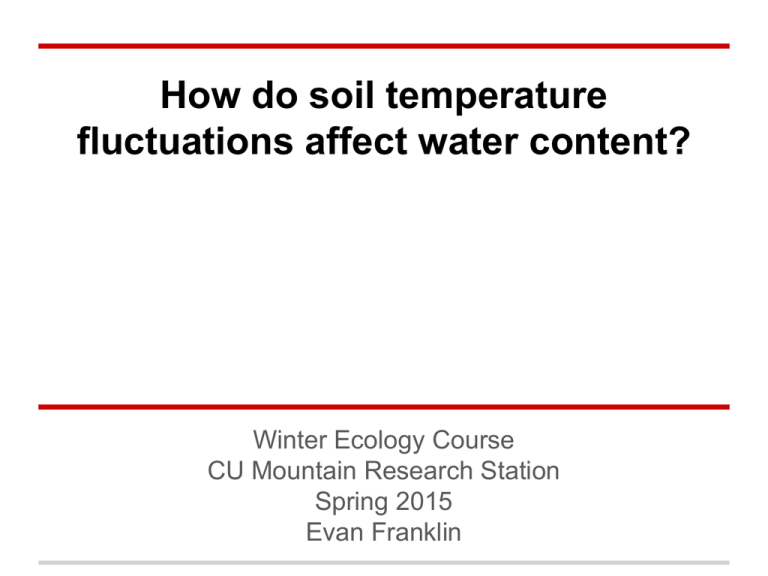
How do soil temperature
fluctuations affect water content?
Winter Ecology Course
CU Mountain Research Station
Spring 2015
Evan Franklin
Soil Temperature + Water
● Water in the winter season is a major limiting nutrient for many organisms,
particularly in an arid alpine environment. Snowpack plays a major role in
hydrating an alpine plant community.
● Plants can uptake water at the leaves and stem, however, root water
uptake is their primary means of hydration. Marchand found mixed results
for leaf water uptake below the snowpack (Marchand 1996).
● Desiccation or winter burn occurs as a result of solar evaporative demand
and low soil moisture uptake, and is a major problem for juvenile
evergreens (Kozlowski 1987), (Brady 2008).
● Root water uptake is primarily a function of soil temperature (Brady 2008).
● A majority of root water uptake occurs in upper portion of soil profile (Brady
2008).
Questions
● How does soil temperature influence a
plant’s available water in winter?
● How do soil temperatures fluctuate on a diel
cycle and across the landscape in the
winter?
Experiment Design
● Took temperature measurements at surface
and 20 cm depth at 7 AM and 3 PM.
● Collected soil samples for gravimetric water
content analysis.
● Recorded snow depth, depth of frozen
ground, and locational attributes such as
slope and aspect.
Identifying Field Sites
● I identified 4 locations with a variable solar exposure
and snowpack levels near the Mountain Research
Station. Two sites were visited in the morning, two
sites visited in the afternoon.
● At each location, I walked a transect and took two
record sets and samples for each of the following
categories: snow-covered + open, snow-covered +
shady, exposed + open, exposed + shady
Results
Fluctuation in Temperature Gradient
Tempereature Gradient ͦC
1
0.5
0.4
0.35
0.3 0.3
0.1
0.35
0.35
0
-0.2
-0.5
-1
-0.8375
-1.5
Average AM
Average PM
-2
-2.5
-3
-3.5
-3.55
-4
Average AM
Average PM
Sun +
Snow
0.35
0.1
Sun +
Bare
0.4
-3.55
Shade +
Snow
0.3
0.3
Shade +
Bare
0.35
-0.2
Interaction P-value: 0.000004465
0.35
-0.8375
Results
• Soil was generally saturated, often in excess
of 20% by mass.
• Daily temperature fluctuations were
minimized under snowpack, regardless of
solar exposure.
• Bare ground saw wide temperature
fluctuations and experienced widest
variability.
• Soil below 20 cm depth saw stable
temperatures, regardless of snow/sun
exposure.
Results
● Gravimetric analysis proved insufficient
Errors?
-Collection problems
-Saturated soils
-Differences in texture, porosity, compaction
-Ice
Discussion
● Bare ground undergoes wider fluctuations.
Solar exposure less important.
● Ground tended to be relatively saturated.
Water at low temperatures drains less
quickly
soil water not limited under
these conditions (Johnsson and Lundin
1991).
● Plant’s water governed by internal processes
rather than availability in winter.
Conclusion
● Plant’s available water is typically high under
snowpack or nearby in the winter.
● Actual soil water content varies as function
of soil physical properties and structure.
● Temperature is a limit of biological and
physical processes in winter.
● Snowpack is a good soil insulator.
Questions?
References
Brady, Nyle C., and Ray R. Weil. "Soil Aeration and Temperature." The Nature and Properties of Soils. Upper
Saddle River, NJ: Pearson Prentice Hall, 2008. Print.
Johnsson, Holger, and Lars-Christer Lundin. "Surface Runoff and Soil Water Percolation as Affected by Snow
and Soil Frost." Journal of Hydrology 122.1 (1991): 141-59. Web. 18 Feb. 2015.
Kozlowski, T. T. "SOIL MOISTURE AND ABSORPTION OF WATER BY TREE ROOTS." Journal of
Arborculture, 2 Feb. 1987. Web. 09 Feb. 2015.
Marchand, Peter J. "Plants and the Winter Environment." Life in the Cold: An Introduction to Winter Ecology. 3rd
ed. Hanover, NH: U of New England, 1987. Print.
Running, Steven W., and C. Patrick Reid. “Soil Temperature Influences on Root Resistance of Pinus Contorta
Seedlings .” Plant Physiology 65.4 (1980): 635–640. Web.







